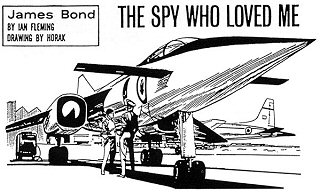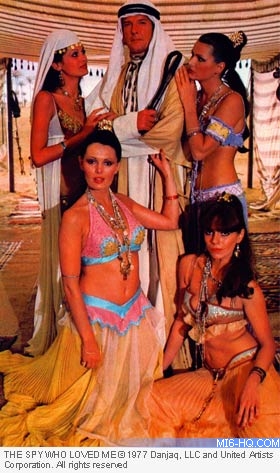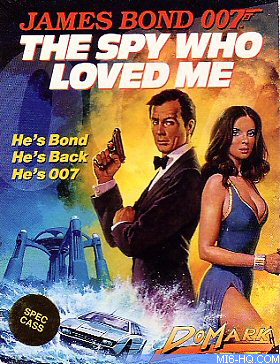|
|
|
 |
| |
MI6 tracks the legacy of "The Spy Who Loved Me", from Ian Fleming's novel, to the comic strip adaptation, feature film and computer game...
|
|
The Spy Who Loved Me - The Legacy
9th July 2012
Summary
With seven successful novels and a set of short stories starring the MI6 agent James Bond 007 released, Ian Fleming tried a different tact. In 1962 the author released "The Spy Who Loved Me", a first person narrative wherein Fleming attempts to get inside the head of a victimised woman, Vivienne Michel. |
|
|
The successful comic-strip duo of artist Yaroslav Horak and writer Jim Lawrence adapted Fleming's source material for a strip that commenced its appearance in the Daily Express in 1967.
Because of the experimental nature and the fact that the book was met with such poor reviews, Fleming refused the rights to EON Productions. Only the title was optioned by the Bond producer, Albert R. "Cubby" Broccoli, when he made his first Bond without the aid of producing partner Harry Saltzman. "The Spy Who Loved Me" (1977) was an ambitious, globe-trotting affair with a enigmatic villain Karl Stromberg. The spy is no longer a direct reference to 007, instead Anya Amassova, an opposite number in the KGB, is invented by the screenwriters. "Spy" was a box office hit, earning $185 million worldwide.
Domark adapted the film storyline, which had become the far more memorable affair for fans of the franchise, releasing a video game version of "Spy" in 1990 for Commodore 64, Spectrum 48K, Amstrad CPC, DOS and others. The basic 8-bit game failed to wow fans back in the early '90s and would be Domark's last VG adaption of a film.
The Novel
Fleming's eighth James Bond novel is set in a sleepy American town and told from the first person perspective of the heroine, Vivienne Michel. The first nine chapters do not feature the world's famous secret agent that had been so good to the author to date. The tried and true 007 formula is forgotten in exchange for a character exploration that may seem to modern reviewers weak and sexist.
Vivienne Michel is a young woman hired to watch over an empty motel, overnight. Trouble starts when two men come out of the night - Sol Horror and Sluggsy Morant. It soon becomes obvious they have criminal intentions, and that she isn't meant to come out alive. Then a third man arrives by the chance of a flat tyre: Bond - James Bond.
 "The Spy Who Loved Me" Literary Coverage "The Spy Who Loved Me" Literary Coverage
"He was about six feet tall, slim and fit. The eyes in the lean , slightly tanned face were a very clear grey-blue and as they observed the men they were cold and watchful. |
|

Above: First edition cover art designed by Richard Chopping and published by Jonathan Cape.
|

 "The Spy Who Loved Me" Comics Coverage "The Spy Who Loved Me" Comics Coverage
|
|
The Comic Strip
The 18th story to be adapted for serialised release in the Daily Express, "The Spy Who Loved Me" was adapted by Jim Lawrence and inked by Yaroslav Horak. It debuted in the press on 18th December 1967 and ran until 3rd October 1967. "Spy" was left by the comic-makers as the last Fleming adaption, for all intents and purposes, Fleming's novel did not have enough hair-raising action for a successful year-long comic.
|
Indeed, "The Hildebrand Rarity" was prized above this rogue Bond novel. Titan books released a "Spy" volume that included the headline story and the following, original adventure "The Harpies". on 26th February 2005.
The Film
Roger Moore returned for his third outing that promised to be the biggest yet. With an original screenplay by Christopher Wood, "The Spy Who Loved Me" sees 007 hot on the tail of missing defense tech, and this time he is on the same side as the KGB in a bid to stop a megalomanic billionaire from heating up the cold war.
The principal cast includes: Barbara Bach, Curt Jurgens, Richard Kiel, Shane Rimmer and Walter Gotell.
An early draft of "The Spy Who Loved Me" featured the return of Blofeld but was nipped in the bud when Kevin McClory - who was preparing the ill-fated "Warhead" at the time - again threatened to sue. The title is not used anywhere in the film but is echoed in the plot device of an alliance between British and Russian agents.
"Commander James Bond, recruited to the British Secret Service from the Royal Navy. License to kill and has done so on numerous occasions. Many lady friends but married only once. Wife killed..." |
|

 "The Spy Who Loved Me" Movie Coverage "The Spy Who Loved Me" Movie Coverage
|
Music
John Barry takes a break from the Bond series and the '70s funk/synth sounds are used to great effect by composer Marvin Hamlisch. Born in New York in 1944, the three-time Oscar winner Marvin Hamlisch had pre-007 success with the popular films "The Way We Were" (1973) and "The Sting" (1973), but was best known for his work on musicals. Hamlisch described the opening to the film in a 2006 television documentary, "the soundtrack starts off with a very hot lick, which to be honest, copped a feel of something that was on a Bee Gees record that I just loved." Hamlisch was the first composer in the Bond cannon to incorporate several pieces of classical music, including Bach's Air in Orchestral Suite and Chopin's Nocturne No. 8. The title song was also the first of its kind, a Bond theme that is not named after the film for which it is written. Carole Bayer Sager provided the lyrics to the song and Carly Simon ably provides vocals.
 "The Spy Who Loved Me" Music Coverage "The Spy Who Loved Me" Music Coverage

Above: Cover art for the Domark Bond game "The Spy Who Loved Me"
|
|
The Game
Fundamentally a top-down racing game, but with an underwater twist, "The Spy Who Loved Me" takes only the minimum details from the film required to satisfy the licence. 007's Lotus Esprit appears in both guises as the central "character" of the game.
The game consists of levels focused on each vehicle: Lotus Esprit (road), Lotus Esprit (underwater), speedboat, and wet bike (jet-ski). The first part of the game uses the Lotus in Sardinia, the middle section is more of a shoot-em-up style top down scroller using the Lotus underwater against Stromberg's troops, and the final section utilises the speedboat and wet bike. 16-bit versions are treated to additional scenes where XXX must defend Bond by shooting Stromberg's attacking troops whist 007 explodes a nuclear charge, a mini puzzle game where 007 must reprogram the targeting computer by matching a series of symbols, and Bond battling Jaws whilst Stromberg attempts to make a run for it.
 "The Spy Who Loved Me" Game Coverage "The Spy Who Loved Me" Game Coverage |
|
|
|